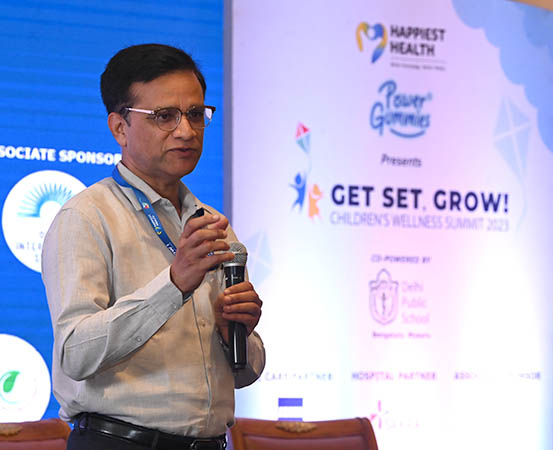
Gadgets have become an indispensable part of modern living. But while breaking ties completely with gadgets and the internet may not be practical, promoting responsible gadget use and reducing overuse in children have become urgent priorities.
Speaking at ‘Get Set, Grow!’, Happiest Health’s children’s wellness summit held on September 22, Dr Manoj Kumar Sharma, professor of clinical psychology and coordinator, Service for Healthy Use of Technology (SHUT) clinic, NIMHANS, Bangalore, said that gadget addiction in children is a reality for some and the need of the hour is to teach and demonstrate responsible use of gadgets and mobiles to them.
While overuse of gadgets is seen among most kids, gadget addiction is seen in not more than 2%-3% of children, he said.
“The problem is when recreational use slips into recurrent use, which can escalate into problematic or addictive use,” he said.
The consequences of gadget overuse in children can be seen in the form of lack of communication with family, social isolation, not playing outdoor games, resorting to a sedentary lifestyle and not sleeping enough, Dr Sharma said.
Gadgets and the joy of missing out
According to Dr Sharma, one of the key factors in establishing a healthy relationship with gadgets is making the transition from feelings of FOMO (fear of missing out) to arriving at a sense of JOMO (joy of missing out).
FOMO is an anxious feeling that you may miss fun events that other people are enjoying. This feeling is especially sparked by things one sees on social media, prompting one to keep constant tabs.
JOMO is all about being in the present moment and being content, without worrying that something more interesting is happening elsewhere.
“A key aspect of responsible internet use is to find alternate modes of gratification and not solely resorting to the internet for one’s need for affiliation and acknowledgement,” said Dr Sharma.
He said kids derive a sense of affiliation and acknowledgement from social media and online games. Social media allows them to discuss and vent their feelings — which is probably not happening in their homes.
The internet also provides kids anonymity and there is no fear of being judged, he added.
Gadgets and the internet
Speaking about the need to intervene and teach children how to use the internet responsibly in an era of cyberbullying and lack of safety measures, Dr Sharma said that there is a need to build a skill set in children to enable them to gradually regulate gadget use. “Developing the skills of talking, reciprocation and communication are important for developing responsible internet and technology usage,” he said.
It is not realistic to completely stop the use of gadgets or withhold them from children, but they must be taught that mobile use has to be regulated.
“Tech can be used productively; don’t completely stop it,” he said. “It can be used for social connection, communication, coping, augmenting knowledge and recreational use when it improves quality of life and well-being.”
Nomophobia is a reality
Dr Sharma mentioned that everyone suffers from nomophobia (or no mobile phone phobia). “The fear of being away from phones is increasingly seen among mobile-phone users — the fear and anxiety of missing something while not using the phone,” he said. “Not being ‘updated’ is a major factor in nomophobia. Not just children, but adults too suffer from this.”
Ways to overcome gadget overuse
Dr Sharma talked about a 4D strategy for promoting healthy gadget use in kids:
- Digital literacy: Parents should acquaint themselves with features like parental controls that can help regulate children’s gadget use. Apps like YouTube, for example, have kid-friendly versions with content tailored for children.
- Digital hygiene: Kids should be encouraged to take breaks frequently amid gadget use. After every 30 minutes of gadget use, they should engage in exercises like blinking, stretching their neck and rotating their wrists.
- Digital fasting: Digital fasting involves having periods where children stay away from tech use. Instead, they engage in in-person conversations and forge meaningful relationships outside the virtual world.
- Digital resilience: Building digital resilience involves equipping kids with knowledge about using technology productively to enhance their lives. Children should be counselled to let go of the need to know everything.
Takeaways
Lack of communication, social isolation and not playing enough are among the consequences of gadget overuse among children. While there is always a thin line between healthy and unhealthy use of gadgets, regulating their use can make a difference, say experts.

















